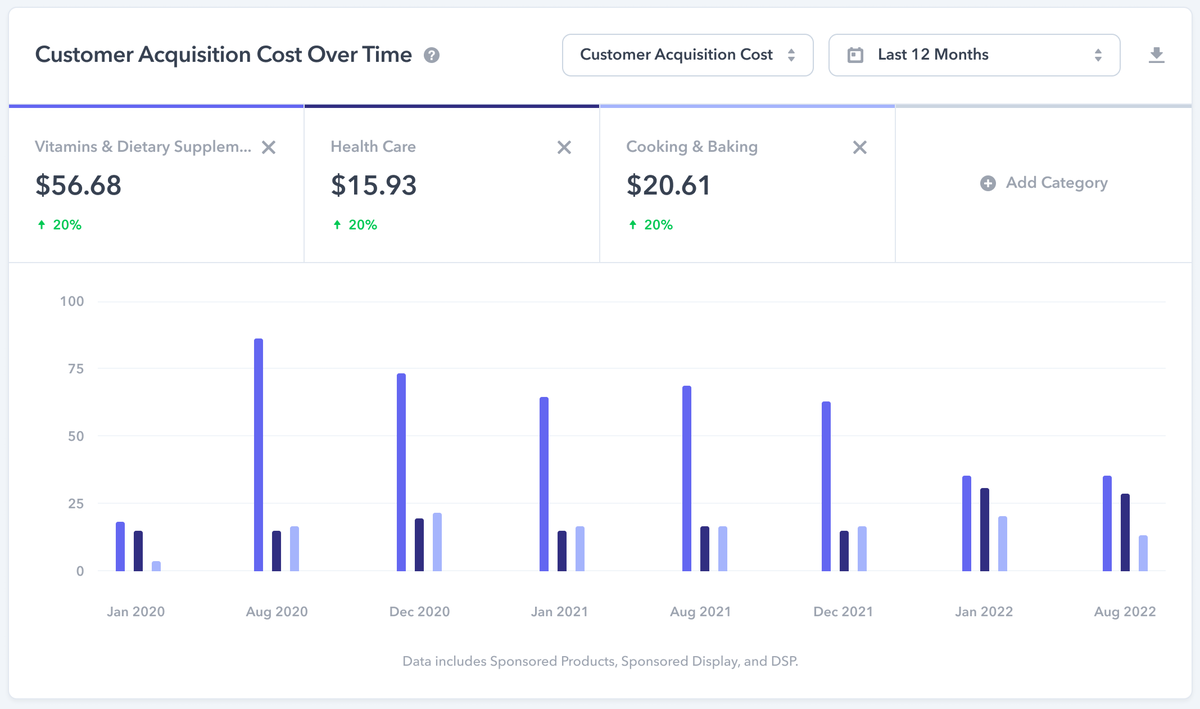
Analyzing your LTV to CAC ratio with the Amazon Marketing Cloud
Stephen Bench-Capon, June 15, 2023
Table of Contents
Customer lifetime value (LTV) and customer acquisition cost (CAC) are two KPIs you can use to generate insights into the profitability of your Amazon business. These kinds of metrics aren't available in your run-of-the-mill Amazon Ad Console views, but with the power of the Amazon Marketing Cloud (AMC), and the know-how to use it, you can drill down into the success of your advertising efforts, and discover which levers you can pull to improve results.
What is LTV in Amazon Advertising?
The lifetime value of a customer is typically defined as the total revenue that will be generated from the time a customer makes their first purchase through to when they are no longer paying money into your business. LTV is commonly used for subscription services, where it is easily calculable. If customers pay $20 a month and the average contract runs 18 months before termination, then you have an LTV of 20 * 18 = $3,600.
For Amazon advertisers, the principle is the same, but the method is slightly more complex, relying on AMC's capability to differentiate between new-to-brand purchasers and repeat purchasers. Returning customers on Amazon don't have a subscription per se—they are not paying a fixed rate at a regular cadence—but if somebody buys the same $200 product four times between May and July, then these three months can be considered their customer lifetime, and the LTV is 4 * $200 = $800.
The Amazon Marketing Cloud (AMC) is a data clean room, so you don't get individual customer information, showing you that Jeff B. from Seattle bought your top hair gel product four times in the last month. However, you can query the anonymized, aggregated data to generate the insights you need and understand your shopper behavior patterns in detail. Find out more in our blog article: What is the Amazon Marketing Cloud?
What is CAC in Amazon Advertising?
To measure your customer acquisition cost, it isn't enough to know how many conversions you are making—you need to know how many new-to-brand customers are coming in. The Amazon Marketing Cloud can tell you this. By dividing your Amazon advertising spend by the number of new-to-brand users in any given period, you can easily see how much it cost on average to acquire each new customer. That's your Amazon Advertising CAC.

How to calculate LTV to CAC ratio?
To calculate your LTV to CAC ratio, you simply divide LTV by CAC. Combining LTV and CAC into a single performance indicator gives you a clear expression of profitability. CAC is essentially how much you are spending on each customer, and LTV is how much they are paying you. The ratio of LTV divided by CAC is therefore equivalent to the amount of dollar revenue for every dollar invested in generating new customers.
Be aware when looking at your LTV to CAC ratio that LTV is based on the revenue from attributed ad sales, not on your profits. You should always factor in your margins when assessing LTV to CAC ratio, as these will determine how profitable your investments in acquiring new customers and encouraging repeat purchases really are.
How does the LTV to CAC ratio differ from ROAS or ACOS?
Other common metrics for assessing the profitability of advertising are return on ad spend (ROAS) and advertising cost of sale (ACOS). These are both calculated as the simple ratio between ad revenue and ad spend. ROAS is revenue over spend and ACOS is spend over revenue.
With ROAS or ACOS, you get an idea of your advertising efficiency in any given time period, such as a month, but you don't get the additional insight into customer lifetime dynamics. If you have a steady month-over-month ROAS, but you have managed to increase your LTV to CAC ratio, then this suggests you are winning new customers at a more profitable rate. This is a leading indicator for expected increase in ROAS, as these customers stay loyal and make repeat purchases.
LTV to CAC ratio is naturally less than ROAS. As your proportion of new-to-brand customers grows, these two KPIs will become closer together. In a hypothetical situation where 100% of your customers were new-to-brand users, your ROAS and LTV to CAC ratio would be identical.
What contributes to your LTV to CAC ratio?
As an advertiser, there are some metrics you have direct control over. Ad spend is one of these, as it's only a slight oversimplification to state that you can set your budget to essentially determine how high your ad spend will be. LTV and CAC are different, as they are both dependent on various other metrics. To see what goes into your LTV, we can look at the following table.
Metric | # Customers | Orders per customer | # Orders | Average order value | $ Revenue | LTV |
|---|---|---|---|---|---|---|
Value | 20 | 4 | 80 | $30 | $2,400 | $120 |
Using these metrics, the formula for LTV is the orders per customer multiplied by the average order value. Here: 4 * $30 = $120.
To get your CAC, you need to know your ad spend and the number of new-to-brand customers.
Metric | # Customers | % of new-to-brand customers | # New-to-brand customers | $ Ad spend | CAC |
|---|---|---|---|---|---|
Value | 20 | 40% | 8 | $500 | $62.50 |
Using these example numbers, the LTV to CAC ratio would be $120/$62.50, which comes out at 1.92.
Which levers can you pull to improve your LTV to CAC ratio?
If we break down the formula for calculation, then we can easily identify the levers that can impact your LTV to CAC ratio:
New-to-brand customers: Increasing the proportion (and number) of new-to-brand customers will benefit your LTV to CAC ratio. Clearly, if you do this simply by investing more in customer acquisition, then it won't help your profitability. It's imperative that you analyze your ad campaigns that target new-to-brand users, such as competitor conquesting, and double down on those that perform the best. If you're not yet doing so, try out upper-funnel Amazon DSP campaigns and test different options to see what works. For any campaigns that show room for improvement, you can make changes to finesse the creatives, audience segmentation and/or keyword targets, and monitor if these have a positive impact.
Orders per customer: If you can encourage more orders per customer, then this will push up your LTV to CAC ratio in proportion. Two ways of achieving this are:
Run ad campaigns that target existing customers. If you don't want to increase ad spend to do this, you may be able to shift budget from more general campaigns to those that focus on existing customers.
Lower your product prices. However, this will bring down your average order value, which will negatively affect your LTV to CAC ratio, so always monitor how price changes affect shopper behavior.
Average order value: A higher AOV will lead to a higher LTV to CAC ratio, provided the number of orders per customer remains steady. Besides raising prices (which may harm your orders per customer), you can increase basket sizes by implementing cross- and/or up-selling strategies. Returning customers who already trust your brand are a well-primed audience for advertising campaigns that promote your lesser-known ASINs.
Ad spend: Raising budgets is the most direct lever you can pull to gain impressions for your ads. If you do this without any real strategy, however, there is little chance of improving your LTV to CAC ratio. More budget can increase volumes and be a great driver of sales, but it's how and where you leverage this budget that will have a real impact on your profitability.
These examples show the importance of understanding how these metrics interact with one another, and how analyzing your LTV and CAC can show you where adjustments to your advertising campaigns will drive positive change.
How to improve your profitability with AMC Audiences
AMC doesn't just help identify which levers to pull to improve your profitability. With AMC Audiences, you can also take insights from your analysis and put them into action, targeting highly specific user groups based on metrics that are unavailable elsewhere.
One example could be if you have a particular product that performs less well with new-to-brand users. For this product, you can use AMC to build and target an audience consisting of high-LTV customers who have already bought at least two of your brand's products, but not the product in question. In this way, you're focusing your ads on an audience that is most likely to buy, pushing up the profitability of your campaign.
The importance of segmentation
Account-level advertising metrics give you a top-level overview of performance, but the more specific the context of any datapoint, the more insightful it can be. And LTV to CAC ratio is no different, which is why segmentation, such as by product category, is so important.
Some categories will naturally lend themselves to repeat purchases more than others. Household supplies are a classic case of a consumable product that will have loyal customers coming back again and again. These are strong candidates for high LTV ASINs.
If you are focusing on your LTV to CAC ratio, then a high LTV means you can afford to invest more in acquiring new-to-brand users within that category. This could mean using upper-funnel strategies such as OTT/Streaming TV Ads to create demand amongst new audiences.
In other categories, it may be that you are successfully winning new customers and your CAC is low, but that retention (increasing orders per customer) is the bigger challenge. In such situations, strategies that retarget existing customers would be more appropriate.

Tracking your LTV to CAC ratio over time
By looking at how LTV to CAC changes over time, you can trace the impact of your activities. If you've implemented a retargeting campaign with the expectation of increasing orders per customer in a particular category, then you can clearly see if it has paid off in the development of your LTV to CAC ratio.
Similarly, if you stop running an ad campaign that you have decided is overspending, then the subsequent change in your LTV to CAC ratio will show you whether your profitability has improved. Any changes you make should always be based on data, have a clear goal, and be monitored so you can assess their impact.
Conclusion: AMC gives advertisers unique insights
Advertisers looking to grow a brand in the medium and long term can use their LTV to CAC ratio to gain insight into the profitability of their ad campaigns. Thanks to the Amazon Marketing Cloud, advertisers can understand the balance between investment needed to win new customers and the cost of generating repeat sales. Informed by this data, they can identify which specific levers to pull to make efficient use of their budgets and achieve their advertising goals.
Want to learn more about AMC Audiences?
Find out how you can use Perpetua to build custom Amazon Marketing Cloud Audiences and take your targeting to the next level.
To get started or learn more about how Perpetua can help you scale your Amazon Advertising business, contact us at hello@perpetua.io